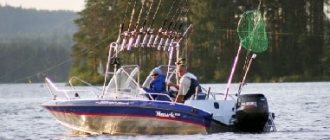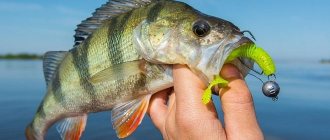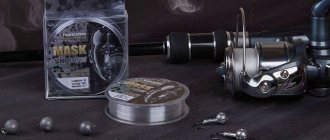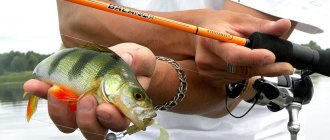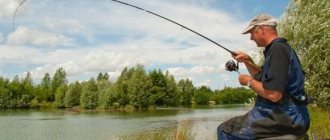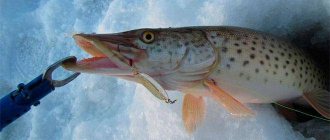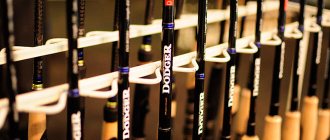Popper is one of the most famous spinning baits, and quite catchy. This attachment is often used for hunting predatory fish on a spinning rod. This is a kind of wobbler. Its shape imitates a frog, a small fish, or a large insect, which, with splashing and squelching sounds, moves away from the predator during the retrieve.
“Popper” in translation will mean “gurgling”. The name is well deserved - thanks to the small hole that is located in the front part, it, walking along the surface of the reservoir, will create fountains of splashes and make gurgling sounds.
And the recess, which is located in the bow, will affect the volume of the bursts and their tonality.
Selected models are equipped with:
- “rattles” that will create additional acoustic vibrations;
- special chambers for attractants.
This bait is good for all types of predatory fish. Can be used in water bodies overgrown with algae, coastal vegetation and snags.
Design Features
The popper has no blades, but there is a notch at the front. The head has a slight bevel, or resembles a bit of a semi-ellipse. There are plenty of such models, although they have some similarity in design, they have different:
- shape;
- recesses in the “nose”;
- varied loading;
- location in a body of water.
It is equipped with two tees and a tail fin, or edge. Of course, plumage is unnecessary for pike, but it will encourage perch to attack.
How the bait works
The operating principle is quite primitive: the bait swallows water bubbles with its concave part. Then, with a characteristic sound, they will fly out of the popper when moving, and scatter splashes in all directions. A similar behavior of a wounded fish is created, and this attracts predators.
When he is thrown into the water, he immediately lies down on it at an angle with his notched mouth and head up. If you jerk the spinning rod sharply, it will dive, capture an air bubble, and immediately emerge to the surface of the water. And during a jerk forward, it will “spit out” fountains of splashes and make corresponding sounds.
What weather is best for popper fishing?
The ideal conditions for popper fishing are calm, windless weather. However, the presence of a light breeze and light rain is also not critical.
If there is a strong wind raging on the reservoir, forming waves, the specific gurgling of the popper will be hard to hear in the water, and because of this, the chances of fishing success will naturally decrease.
Also, strong wind makes it difficult to cast light baits, blowing them to the side. In bad weather conditions with wind and precipitation, the fish tend to go deeper, and fishing with surface poppers becomes a futile exercise.
Varieties of poppers
Specialized stores have a good selection, they come in: sinking, floating, suspenders.
Drowning
Sinking baits are heavier than floating baits. When casting, they should immediately sink to the required depth, and when jerked upward, they should rise to the surface and at the same time produce characteristic sounds. The fish is more willing to use this bait because it does not arouse suspicion.
In the water, the predator sees the popper well, and this helps it not only aim well, but also swallow it. Sinking baits are used to find predators. They have a long range; wiring is carried out only in the near-surface layer of water.
Floating
Floating baits are designed for surface fishing of predators. It is more advisable to use them in overgrown reservoirs, where the surface layer of water is densely overgrown with algae or grass. Usually pike live in them, and the floating bait freely passes through all obstacles without touching them.
Floating popper Salmo ROVER F
Popper classification
The range of poppers is huge. They differ in many respects, but they are mainly classified according to the type of load. Poppers are:
- front loading;
- medium load;
- rear loading.
Advice!
If you have to fish quite far from the shore, and you need a very long cast, then a rear-loading popper is best suited. After being thrown, the bait flies very accurately and sinks its heavy part into the water by 35-40 cm. It is worth fishing in places where there is a space of 50 cm free from snags and algae. In models with medium weight, the weight is evenly distributed throughout the body, so flight range is slightly worse. It enters the water flat, but does not sink more than 10-15 cm. Such models can be used in overgrown places where algae almost reaches the surface of the reservoir.
Attention! Front-loaded poppers are not able to fly very far when thrown, but they only submerge a few centimeters in the water. This feature allows them to be used in the most overgrown and impassable places for other baits.
It is better to catch them and throw them when the predator is not very active. Posting a popper allows you to interest almost any fish. And if you make several reels, the bait will sink deeper, which will provoke a throw.
Fishing places where bait is used
It is used mainly in various shallow waters, preferably without current. Where there is little water and a lot of duckweed and grass:
- shallow bays;
- floodplain lakes;
- overgrown river oxbows;
- marshy ponds.
Productive fishing can also be:
- In the warm season, on clean water, at dawn. At this time, the fish are most active.
- You can hunt from a boat, under overhanging trees. Only here you need some experience.
Popper selection criteria
When choosing a popper, consider everything:
- its color;
- size;
- price;
- balance them with your casting skills.
If the bait has a lot of weight, then this can create some inconvenience when casting. We know that there are only three types of such bait: floating, sinking, and suspenders. The most common ones are floating ones.
If you plan to hunt with long casting , then it is optimal to use sinking poppers . This is a particularly long-range bait, because the difference in casting can sometimes even reach 20 m.
Take into account the nature of the wiring; it must be:
- high-speed;
- aggressive;
- reduce the intervals between broaches to a minimum.
If casting range is not so important and you plan to hunt in an overgrown pond , then use floating .
Size
The dimensions must be selected especially carefully; the effectiveness of the bite will depend on this:
- From 5 cm and more, can be used for any predatory fish species.
- In summer you will need larger nozzles, up to 9 cm.
- At the beginning of autumn, it is better to use large ones, up to 12 cm.
For hunting:
- pike, stock up on 8–9 cm of bait;
- catch perch at 4–5 cm;
- for large predators you will need at least 10 cm.
If you fish not according to the rules, for example, with less than the required weight and length of the bait, then do not expect a good trophy.
Elasticity
When hunting a popper, the sound it emits is especially important, and this requires more elastic models.
Color
Color will not play a decisive role, because the fish can only see the popper from below, against the sky. The main rule of a good catch is contrast . It is desirable that the lower surface of the bait has a bright color, this will increase visual control during wiring.
Color, as we previously noted, is not significant, but with different water illumination, time of year and day, a certain color may be more catchy than others.
The most widespread are:
- grayish green;
- silver;
- orange-yellow;
- white with a reddish head.
Choose according to the principle - the front part must be brightly colored, this will help you easily distinguish it in the water, and easily adjust them when retrieving.
Weight
Weight can vary from 5 to 16 g. The preference for a certain parameter will depend only on what kind of fish you are going to hunt. It's better to choose a thicker one. Because the thicker the popper you use, the louder it will “gurgle.”
And select the weight and size based only on what kind of fish you are going to catch, but with a size of at least 50 ml and a weight of 4 grams. You can’t take less, otherwise the weight will be insufficient for casting, and the gurgling will be unnoticeable.
Form
Its shape is an important factor for productive hunting. The main element is a small recess in the bow. This small depression has different depths and sets the acoustic play. And it will determine its “tone”. The preference for one model or another will directly depend on the choice and experience of the fisherman. These nozzles have different shapes, but mostly they are cone-shaped.
Sebile Splasher
Models come in thick and thin:
- Thick ones will produce louder sounds and a larger fountain of splashes. But their trajectory is designed for straight movement.
- For thin ones , during wiring, the gurgling will be weaker, but they can move sweepingly from side to side.
The use of thick poppers is justified when there is a big wave, and thin ones are good for the cold season.
Choosing a popper for pike
The effectiveness of popper fishing for pike largely depends on the chosen bait. A popper is a surface bait used to catch predators. The term “popper” itself is derived from the English word “pop”, which in approximate Russian translation means “to gurgle”. In shape, this bait looks like a wobbler, with a small indentation in the nose, thanks to which, when retrieved, the popper makes its characteristic gurgle, thereby attracting predatory fish.
One of the main advantages of a popper is the minimum number of hooks, since it is not afraid of snags on the bottom, because its element is the surface.
Size. Experienced spinning anglers most often choose an average popper size from 5 to 13 centimeters for fishing. In their opinion, the most catchy baits of this type are in this size range.
Color. Let's look at a few rules for choosing the color of a popper for a pike.
- If the selected pond has muddy water, then it is better to choose a popper in light or bright colors. The fact is that they will be more noticeable under such conditions and it will be easier for the pike to see and attack them.
- If the pond has clear and clean water, then you need to choose dark poppers. According to experienced spinning anglers, such a choice of colors will not be too intrusive and will not scare away the pike.
- Another interesting note we found is that during morning fishing, pike prefer poppers in black, red and orange colors.
However, these rules do not always work 100%, just like any other in fishing, therefore, never forget about experiments.
Rating of popular models
In order for the purchase to be correct and bring the owner maximum adrenaline, you need to pay more attention to well-known companies. The following models are used even by professional fishermen. They can catch fish of various types and sizes.
Rebel POP-R
Rebel POP-R
Its main feature is the release of a nozzle, which has three different weights and sizes:
- 52mm/4g;
- 64 mm/8 g;
- 64 mm/14 g;
- 6.4 cm/16 g.
This means you can easily choose the right bait for any fish.
Daiwa TD Popper Zero
This is a unique, surface bait. In this, it is clearly a leader. It acts very realistically and is used to catch small predators.
Its parameters:
- weight 6 g;
- length 7.5 cm;
- has two hooks with 3 points.
Daiwa TD Popper Zero
ECOGEAR TP 88F
It gurgles like a real popper, rushes and wobbles no worse than Walker. Characteristics:
- hooks - 2 tees, placed in the middle and behind the bait;
- length – 8.9 cm;
- weight – 16 g.
ECOGEAR TP 88F
Rapala Skitter Pop
This is a surface attachment, their shrinkage is shallow. It will not go under water, and is especially good for novice fishermen. It is better to practice wiring techniques on it. It’s easy to make it gurgle as it should; it’s equipped with special blades.
Designed for hunting small predators, because larger ones can easily damage it. And one more minus - not a very good flight. Probably because they are light in weight. The working qualities are excellent, pike and perch can be easily caught in any body of water.
Rapala Skitter Pop
JACKALL BROS SK-Pop Grande
This popper will have a special shape, and the placement of its hooks will be interesting. It is easy to use, will produce a pleasant sound during operation, has a length of 8.5 cm and a weight of 10 grams.
Attracts perch and pike of all sizes, because it has excellent flight properties, a short but sonorous “gurgle”.
JACKALL BROS SK-Pop Grande
Features of the structure of the gear
- The bait must be weightless so that it can float easily. To cast it with a mass of several grams, it is better to take a spinning rod with a test corresponding to its weight. This will allow you to make accurate casts.
- The throwing range will be of secondary importance. Because it is not necessary, especially in polluted water. If you cast too far, it will be difficult to observe.
- St.Croix Avid
rod , this will allow you to easily control it with any retrieve. It should not be short, so that there is a real opportunity to bypass all possible obstacles with bait. If the spinning rod is too long, it will be difficult to control. It is more convenient to eliminate shortcomings on a short rod. If it is long, then each time you have to wind the line from the reel to get to the bait. The ideal spinning rod is St. Croix: series – Avid, length – 2.35 m, test up to 15 g. - on the reel ; it must guarantee smooth laying without overlaps, with irregular wiring with large jumps and sudden stops. The tension of the fishing line will change repeatedly, changing when winding on the spool without load, and with load. This means that when the reel cannot provide even winding, then “beards” will be inevitable when casting. The fishing line should be braided, almost inextensible. It should provide the necessary sharpness during wiring.
- a leash not braided (it will twist in rings), but made of steel string. The length of the leash needs to be longer, this will avoid damage to the fishing line, the fish may miss when attacking it, which means the fishing line will suffer.
Fishing technique and tactics
To fish with a popper you need:
- specially tuned tackle;
- gaining wiring experience;
- knowledge of individual features in the use of this bait.
Technique:
- After throwing the bait, you need to pause for two seconds.
- During this time, the bait will take the right position.
- Throw the reel bail and pick up the desired slack for the fishing line.
- Lift the rod tip slightly and make a small jerk, approximately 20 cm.
- The popper will definitely respond and also make a dash forward, this will be accompanied by appropriate sounds.
- Pause again for 2 seconds, select a weak spot on the line, and make a jerk, etc.
To make the bite tempting, use different wiring:
- When retrieving slowly, you can easily force the bait.
- With rough jerks, it begins to jump across the water floor and imitate a fry running and jumping out of the water, as if it were being attacked by a predator.
- To simulate the movement of a frog, pulsating wiring is used. To do this, first they will give a slight acceleration - twitching the tip of the spinning rod. Then, by reeling the reel evenly, you will make it slide easily, pausing the retrieve for a second, and then speeding it up again, twitching the rod tip as you do so.
Classic wiring
With classic wiring, you need to rotate the reel handle rhythmically and constantly. And make short, methodical jerks with the tip of the spinning rod.
It is necessary to select individually for a specific model. For example, when driving a 3D popper at a distance, you need to lift the spinning rod almost vertically, this is necessary to stabilize its operation.
The closer the bait, the lower you need to lower the tip. With this tactic, the popper will look equally tempting after casting and at the feet. This wiring is universal, but its optimal use is for an active predator.
Uniform wiring
Slow wiring
Slow wiring is done with long stops and pauses. It is indispensable when predators are passive. She forces the inactive predator to quickly rush at her.
Slow even retrieve
Chaotic wiring
Chaotic wiring sometimes works, even in completely hopeless situations, it awakens a brutal appetite in predators. It is simple, but will require composure.
It is carried out in the following sequence:
- first there is a series of intense and frequent jerks;
- then a short pause of approximately 4 seconds.
Works well in the middle zone, at the end of the autumn season. The essence of this wiring is as follows - there is an imitation of wounded and completely exhausted prey. Consequently, the predator was left without making any special efforts to get enough of the prey.
The effectiveness of such fishing will depend on the purity of the water; the clearer it is, the greater the chances you will have. The wiring pattern can be different, it will depend only on the imagination of the fisherman.
Popper fishing
Fishing with a popper
Popper can be a very catchy bait in certain conditions. It can bring incomparable impressions of a predator attack on the surface, but it can also leave you with nothing. For successful fishing, you need to take into account the mood of the predator and its location.
You should not fish (without visible manifestations of surface activity) over a 5-meter hole, you should not try to catch a predator in overheated shallow water overgrown with thread on a hot summer day, etc. But we must not forget that although miracles do not happen in life, anything is possible when fishing.
A huge advantage of poppers over other baits is that they are very difficult to lose, so you shouldn’t save much on them. You shouldn’t start mastering this most interesting bait by buying outright junk. Any company has poppers in its product range; beginners are recommended to start with Skitter Pop from Rapala and 3d Popper Yo-Zuri, as they are easy to control, catchable and relatively inexpensive.
As for the color of the poppers, this factor is not decisive for the fish. The predator sees the popper from below, against the sky - contrast is important here. It’s not bad when the front surface of the bait is painted in a bright color - it increases visual control when retrieving.
The “target audience” of the popper is mainly pike and perch. Fishing is carried out in shallow water, preferably in “calm” water - on rivers, lakes, ponds, quiet creeks. It is understood that the fish actively react precisely to the noise made by poppers, in contrast, for example, to minnow-class wobblers, which are pure visuals (baits where appearance plays the main role). The active bite on poppers in different regions may differ depending on the time of year, which is due to different periods of open water and, accordingly, the activity of aquatic fauna, frogs, etc.
Popper wiring
Wiring a popper
Popper is most often carried out with pauses of varying durations. This bait makes a characteristic sound when there is a sharp jerk with the rod, which when retrieving it is advisable to keep it as low as possible to the water and with the tulip in the direction of the bait. The manner in which the popper is deployed depends on the circumstances. A strong jerk of the rod and a correspondingly loud sound are advisable when it is necessary to attract, for example, a school of perch feeding away from the fishing spot or at depth, in wind and waves. In calm conditions, it is enough to make a soft gurgling sound, since a loud bang can scare the fish.
The standard technique for wiring a popper is as follows. After casting and splashing down the bait, wait until the wave calms down, then take out the excess fishing line and very carefully make the slightest jerk with the rod, just enough to breathe life into the bait. This technique is typical for almost all surface baits and is liked by predators who, attracted by the noise from the fall of the bait, may be frightened by its first sudden movement.
Further wiring is usually carried out according to one of three options:
- Classical.
You rotate the reel handle evenly and constantly, and make soft, consistent jerks with the tip of the spinning rod. The position of the rod, the speed of the retrieve and the intensity of the jerks are selected for the specific model of the popper. For example, when leading a 3D popper, at a long distance I lift the spinning rod vertically to stabilize its operation. The closer the bait is to me, the lower I lower the tip. Thus, the popper looks equally attractive both immediately after casting and at the very feet. Classic wiring is quite universal, but works best on an active predator. - Slow wiring.
This is done with a lot of stops and pauses. “Saves” when there is little predator activity. You often see how a pike chases a strange gurgling object, but does not risk attacking. It is this wiring that often causes an inactive predator to rush to the bait. - Chaotic wiring.
This method of presenting bait sometimes works even in the most hopeless situations. Wiring is quite simple, but requires concentration. It consists in the fact that the popper is carried out in bursts of fairly intense, loud and frequent jerks, followed by a pause of 3-4 seconds. The method works great in late autumn conditions in the middle zone.
The logic of the wiring is simple, in this case the popper most accurately imitates wounded or exhausted prey, which means that the predator can get enough of it almost without effort, you just need to swim up and bite the tasty morsel. I should also note that the effectiveness of popper fishing directly depends on the transparency of the water: the cleaner it is, the greater the chances of a good catch.
Tips and tricks
- The main rule of successful fishing is the correct selection of jerk force.
- If you fish at great depths , in windy weather, with slight waves, you need to use strong jerks, in calm weather - weak ones.
- Sometimes it is better to first activate the fish with a popper , and then use other baits. Flies or small twisters can be especially tempting for pike.
- The undeniable advantage of these attachments over others is that they cannot be lost, which means there is no need to save on them.
- Good options for beginners : SkitterPop from Rapala and 3d Popper from Yo-Zuri. They are inexpensive, catchable, and easy to manage.
- It is better to go fishing with two spinning rods and different attachments; this will help you quickly adapt to the necessary fishing conditions.
- The best hunting season is the end of May and until the end of August. At this time, frogs begin to become active, and small fish often come to the surface.
Popper fishing
These wobbler options belong to the class of floating baits. They are designed for catching predatory fish near the surface of the reservoir. Poppers for pike or perch are used in those reservoirs where there are dense thickets of aquatic vegetation. These include peat quarries, marshy ponds and lakes, bays and channels. For normal hook-free retrieval of such a bait, a layer of clean water of 5-15 cm is enough.
There are quite original hybrids that, with the traditional concave head of poppers, have a flat “belly”. This shape does not allow the product to dive deeply when jerked. These models require only 3-4 cm of a surface layer of water without vegetation for normal wiring. Therefore, they try to buy poppers precisely for the case when the use of a spinner due to vegetation or snags becomes quite problematic.
There is one more circumstance that must be taken into account when fishing with this bait: the catchability of a popper depends on the time of year. This bait shows good results from the end of May to the end of August. During this period, frogs and small fish are most active.
The possibility of an excellent catch greatly depends on the predators themselves. They have different attitudes towards the appearance of such bait. In some cases, you have to experiment in order to select the optimal model that is of interest to the pike or perch at the moment. Therefore, experienced spinning players always recommend buying poppers with different colors, design features and sizes.


